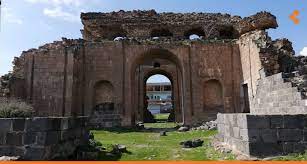The combination of architecture , sculpture and landscape makes cemeteries different in the history. The design of monuments , the choice of stones , the architecture of building and landscape design shed light on past social customs and events and combine together to make a cemetery an irreplaceable historical resource and the biography of its community.
The archaeological cemeteries discovered in different areas of Sweida are of great importance as they highlight the burial customs and funerary rituals in ancient times and reveal buried secrets dating back hundreds years ago.
Head of the Excavation and Archaeological Studies Department at Sweida Antiquities Directorate , Khaldoun Al-Shama’a indicated to the Syrian News Agency (SANA) that the burial customs and funeral rites during ancient times in Sweida are clearly symbolized through the architectural elements and archaeological finds.
He clarified that the cemeteries discovered during the survey and archaeological excavations at the archaeological site of “Tal Al-Masih” ( the hill of Jesus) near the city of Shahba, embody an architectural evidence and archaeological monuments which reflects the ancient civilization of the region.
Al-Shama’a added: “ Due to the spread of tower-shaped cemeteries in the site, it is likely that the building constituted a collective cemetery….. 6 tombs were found in the site which were vandalized in ancient times.”
He referred that after a preliminary study of the architectural structures in “ Tal Al-Masih” , it is likely that the site dates back to the Roman and Byzantine periods when the agricultural activity reached the top .
The “Tal Al -Masih” area is distinguished by its geographical location, its charming mountainous nature, fresh air and its view overlooking the historical city of Shahba.
This area calls our attention , as mentioned by historical sources and references, to the fact that Jesus visited the area roamed the hill and stayed there for more than one night.
Rawaa Ghanam

